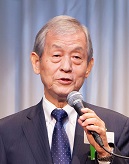India, the Last Superpower, and Japan-India Relationship
October 17, 2018
Mr. Hiroshi Hirabayashi
Representative Director, President
Japan-India Association
”” I published a book entitled ”ČThe Last Superpower”É. It doesn”Ēt mean that India is now a superpower, but it is my gut feeling that it might be a superpower in 15 or 20 years later. The current superpower is certainly the USA, followed by China and Russia though they have various pending problems. Brazil or Indonesia are big countries but they fall short of conditions for being superpowers. That is why I believe that India will be the last superpower.
I published a book entitled ”ČThe Last Superpower”É. It doesn”Ēt mean that India is now a superpower, but it is my gut feeling that it might be a superpower in 15 or 20 years later. The current superpower is certainly the USA, followed by China and Russia though they have various pending problems. Brazil or Indonesia are big countries but they fall short of conditions for being superpowers. That is why I believe that India will be the last superpower.
””Now I will summarize five basic elements for understanding India. Firstly, the size of the country: India is as large as the EU. There are 29 countries in EU, while 29 states constitute India. A big difference is that population in India is 2.5 times larger than the EU, and according to the UN estimation it will become No.1 in 2028. Secondly, India is the world”Ēs largest democratic country. Since its independence it never violated principles of democracy, which is quite rare for developing countries. Its political system is stable with no military regime nor coup d”Ēétat so far. Elections are conducted every 5 years for both national and local assemblies. The result of the election is respected in spite of occasional frauds.
”””ČUnity in Diversity”É advocated by PM Nehru is the third principle. As climatic, racial, historic, linguistic or religious diversities are many times more in India than in any other countries, it is difficult to maintain national unity. However, the system functions well and unity has been maintained. Fourthly, India has always been pro-Japanese. Fifthly, India is located in a strategically and geopolitically important position in Asia and in the world.
””As for religion, 80% are Hindus and 15% Muslims. There are also Sikhs, Buddhists, Christians, Jainas or Zoroastrians. Buddhism was founded by Gautama Buddha in 6th century BC reforming Hinduism and eventually came to Japan in 6th century AD. India and Japan are spiritually bonded through Buddhism.
””There are several hundreds of languages including local dialects, Hindi being an official language and English a semi-official language. Although caste system is a problem which violates the Constitution, the basic human rights are protected and various measures taken to upgrade the lowest caste, Dalit, formerly called ”ČUntouchable”É. As a result, not a few politicians are Dalits. The President at the time I was Ambassador was Dalit, and he was very respectable and a decent man. Poverty class is gradually decreasing, while middle class population increasing; every year 26 million middle class equivalent to the population of Malaysia are born. Lack of infrastructure, regulations, disparity are also a bottleneck of growth. Internally, the rise of Islamic fundamentalists and Hindi supremacists are concerns and external anxiety is the relation with longstanding rival of Pakistan and China, which is now advancing to Indian Ocean via ”ČOne Belt, One Road”É initiative.
””The conditions for being a Superpower are size of land and population, economic growth and a big voice in international society. Strategic autonomy and consistency in diplomacy are also a strength of India. Nuclear deterrence, I believe, is another major condition for superpowers, though it has been criticized in Japan and ODA was suspended for 2 years after nuclear tests of May 1998 immediately after I was appointed Ambassador to India by PM Hashimoto.
””Unique cultural identity, tradition and historical legacy, so called soft power, are also important conditions for superpowers.
””When British suppression in India became severe, leaders of independence movement sought asylum in Japan. Among them were two Boses: Behari Bose who married a daughter of Nakamuraya in Shinjuku and introduced Indian curry to Japan, and Chandra Bose who was a commander of Indian National Army and participated Operation Imphal of Japanese military during WW¶. Both of them died before India became independent in 1947. In 1953 when the San Francisco Peace Treaty was enacted, Japan also recovered full independence. Diplomatic relations were established between our two countries then and India waivered indemnity for Japan.
””Many things happened between our countries since then, but a joint venture, Maruti Suzuki India Limited established in 1982 between Indian national automobile company Maruti and Japanese Suzuki in 1982 worth mentioning, as it remarkably activated the auto industry in India. After the 1st Gulf War, India suffered foreign currency shortage. PM Manmohan Singh, then Foreign Minister, came to Japan and negotiated with PM Hashimoto, then Finance Minister. India was saved from a crisis by an emergency loan. PM Singh repeatedly said, ”ČIndia was not able to survive without an emergency loan from Japan.”É
””After the nuclear tests, relations between our countries declined, so I tried hard to restore amicable relations. In 2000 PM Mori visited India and established Japan-India Global Partnership. The following year ODA (yen loan) suspension for India was lifted so that India could participate in the war on terrorism after 9.11. Global Partnership was handed over as Strategic Global Partnership by PM Koizumi, then as Special Strategic Partnership in 2014 by PM Abe up until now.
””I am not going to touch upon current Japan-India relations, but suffice to say many megaprojects are ongoing.